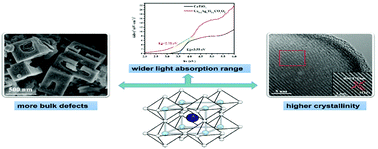Microwave-assisted synthesis of defective Ca1−xAgxTi1−yCoyO3 with high photoelectrocatalytic activity for organic pollutant removal from water†
Abstract
CaTiO3 is considered to be one of the most promising catalysts for the degradation of organic pollutants, but its application is limited by the wide band gap and low catalytic activity. Element doping is an effective strategy to solve these problems. Herein, a novel CaTiO3 co-doped with Ag and Co (Ca1−xAgxTi1−yCoyO3) was synthesized by combining co-precipitation and the microwave hydrothermal method for the first time. The crystal structure, microstructure and light absorption of the material were systematically investigated. The results showed that Ca1−xAgxTi1−yCoyO3 had higher light absorption than pure CaTiO3, and the band gap was reduced to 2.78 eV. First-principles calculations indicated that Ag–Ca and Co–Ti tended to form donor–acceptor defect pairs in the doping process. These defect states not only enhanced the adsorption properties, but also could be used as carrier traps to optimize the dielectric properties of CaTiO3. In the photoelectrocatalytic system, with 0.01 g of catalyst, 98% of methylene blue in 100 mL solution (10 mg L−1) was degraded in 150 min. In addition, Ca1−xAgxTi1−yCoyO3 showed strong stability and excellent recyclability. The double ion co-doping technology will provide an effective strategy for improving the catalytic activity of traditional wide-band gap semiconductors.



 Please wait while we load your content...
Please wait while we load your content...